
Friday, December 25, 2009
Tuesday, December 22, 2009
Happy Holidays!
Poppy and Sparkle had a great time racing through the snow. Lilly on the other hand did not enjoy it quite as much, and did everything she could to avoid any contact.
The Friendship holiday party is a highly anticipated event by all of our staff. This year was no exception and everyone had a lot of fun celebrating the season. The second annual Friendship Awards were handed out and I was honored to be given the Bright Ideas Award for this very blog. Staff members nominate colleagues for each category and then our management team selects the winners. It is a great way to acknowledge how hard our staff works every day.
The award winners are:
Rookie of the Year: Pamela Trujillo
Team Spirit: Amy Burgess
Outstanding Growth: Emmally Yarnell
Outstanding Growth: Dr. Nicola Moore
Client Service: Lizzie Wood
Client Service: JT Means
Dan Ferguson Memorial Patient Care: Juliana Dunbar
Dan Ferguson Memorial Patient Care: Shannon Huza
Admin/Inventory/Ops of the Year: Marcos Vasquez
Doctor of the Year: Dr. Amanda McMurphy
Client Care technician of the Year: Jen Lehmann
Veterinary Technician of the Year: Rebecca Monti

Internal medicine technician Mark with Drs. Choen, Begnoche, Hughes and McMurphy
I will be taking a brief break for the holidays and return on January 5th. If you are dying to read more from me I will be posting on the DCLadies blog January 31st. From all of us at Friendship we wish you a happy holiday and an exciting new year!
Thursday, December 17, 2009
There is no "whispering" with Cesar Millan's training techniques
My last two posts were about behavior modification -- what I, as well as the American Veterinary Society of Animal Behavior (AVSAB), feel is the right way to train your dog. Other lines of thought do exist, among them the method of dominance theory that includes the punitive training techniques made popular in the last few years by Cesar Millan in his Dog Whisperer television program.
 Millan’s training revolves around what known as dominance theory. According to this school of thought, you must establish yourself as the “alpha dog” while keeping your dog in a submissive role. A central theme of this training technique is that dogs that are fearful or aggressive are trying to obtain dominance over their owners or other pets in the house and must be put in their place, often times using force.
Millan’s training revolves around what known as dominance theory. According to this school of thought, you must establish yourself as the “alpha dog” while keeping your dog in a submissive role. A central theme of this training technique is that dogs that are fearful or aggressive are trying to obtain dominance over their owners or other pets in the house and must be put in their place, often times using force.
People who believe in dominance theory will tell you that it is based on studies of wolf behavior in the wild. What they may not be aware of is that these studies were conducted back in the 1960’s and have since been proven inaccurate. In just the past decade we have learned that wolves DO NOT fight to become the alpha dog of the pack; rather, their “packs” are families consisting of a mating pair heading up a group of their offspring.
 Here’s the main problem I see with dominance theory: maintaining your alpha-dog status requires that you routinely behave in a threatening manner – often using physical force--to those submissive to you. And so you must ask yourself: Is that the kind of relationship you really want to create? It’s certainly not one I want to share with my dogs.
Here’s the main problem I see with dominance theory: maintaining your alpha-dog status requires that you routinely behave in a threatening manner – often using physical force--to those submissive to you. And so you must ask yourself: Is that the kind of relationship you really want to create? It’s certainly not one I want to share with my dogs.
Dog Whisperer may be entertaining television, but it should not be used as an example of how to train your dog. Most of Millan’s techniques are primitive and often times inhumane. So much so, that there was a public outcry calling for National Geographic to remove the show after an episode in which Millan used a choke collar on an unruly dog until it collapsed gasping for breath. Though National Geographic did not stop airing the show, they now post a disclaimer cautioning people not to try these techniques at home.
Proponents of Millan argue that he saves animals that would have otherwise been euthanized for aggressive behavior. But it is commonly accepted in the behavioral community that, for most part, aggression in dogs is rooted in fear and mistrust. So the techniques of dominance theory can actually lead to an even more fearful animal. The AVSAB put out a position statement warning that using punishment training for behavioral problems can lead to “potential adverse effects which include but are not limited to: inhibition of learning, increased fear-related and aggressive behaviors and injury to animals and people interacting with animals”.
 Though I don’t agree with his training methods, I’m sure Millan believes he has the animal’s best interest at heart. He is a huge supporter of shelters and rescue foundations. His center in Los Angles takes in many abused and rescued animals that I’m sure would have otherwise been euthanized. Still, I feel that it’s my responsibility as a veterinarian and dog lover to clearly state that I do not believe in following his methods.
Though I don’t agree with his training methods, I’m sure Millan believes he has the animal’s best interest at heart. He is a huge supporter of shelters and rescue foundations. His center in Los Angles takes in many abused and rescued animals that I’m sure would have otherwise been euthanized. Still, I feel that it’s my responsibility as a veterinarian and dog lover to clearly state that I do not believe in following his methods.
In the end, it’s up to you to choose which method to use with your dog. On one hand, you have a method that may initially seem simpler, but is based on research that is no longer valid and requires you to frequently use physical force when your dog acts out. On the other hand, you can use behavior modification to create a situation where your dog has self-control and looks to you for guidance. My hope is that you will embrace the challenge of behavior modification, and use it to create a relationship with your dog that is based on trust and communication – never on fear and intimidation.
 Millan’s training revolves around what known as dominance theory. According to this school of thought, you must establish yourself as the “alpha dog” while keeping your dog in a submissive role. A central theme of this training technique is that dogs that are fearful or aggressive are trying to obtain dominance over their owners or other pets in the house and must be put in their place, often times using force.
Millan’s training revolves around what known as dominance theory. According to this school of thought, you must establish yourself as the “alpha dog” while keeping your dog in a submissive role. A central theme of this training technique is that dogs that are fearful or aggressive are trying to obtain dominance over their owners or other pets in the house and must be put in their place, often times using force.People who believe in dominance theory will tell you that it is based on studies of wolf behavior in the wild. What they may not be aware of is that these studies were conducted back in the 1960’s and have since been proven inaccurate. In just the past decade we have learned that wolves DO NOT fight to become the alpha dog of the pack; rather, their “packs” are families consisting of a mating pair heading up a group of their offspring.
 Here’s the main problem I see with dominance theory: maintaining your alpha-dog status requires that you routinely behave in a threatening manner – often using physical force--to those submissive to you. And so you must ask yourself: Is that the kind of relationship you really want to create? It’s certainly not one I want to share with my dogs.
Here’s the main problem I see with dominance theory: maintaining your alpha-dog status requires that you routinely behave in a threatening manner – often using physical force--to those submissive to you. And so you must ask yourself: Is that the kind of relationship you really want to create? It’s certainly not one I want to share with my dogs.Dog Whisperer may be entertaining television, but it should not be used as an example of how to train your dog. Most of Millan’s techniques are primitive and often times inhumane. So much so, that there was a public outcry calling for National Geographic to remove the show after an episode in which Millan used a choke collar on an unruly dog until it collapsed gasping for breath. Though National Geographic did not stop airing the show, they now post a disclaimer cautioning people not to try these techniques at home.
Proponents of Millan argue that he saves animals that would have otherwise been euthanized for aggressive behavior. But it is commonly accepted in the behavioral community that, for most part, aggression in dogs is rooted in fear and mistrust. So the techniques of dominance theory can actually lead to an even more fearful animal. The AVSAB put out a position statement warning that using punishment training for behavioral problems can lead to “potential adverse effects which include but are not limited to: inhibition of learning, increased fear-related and aggressive behaviors and injury to animals and people interacting with animals”.
In the end, it’s up to you to choose which method to use with your dog. On one hand, you have a method that may initially seem simpler, but is based on research that is no longer valid and requires you to frequently use physical force when your dog acts out. On the other hand, you can use behavior modification to create a situation where your dog has self-control and looks to you for guidance. My hope is that you will embrace the challenge of behavior modification, and use it to create a relationship with your dog that is based on trust and communication – never on fear and intimidation.
Tuesday, December 15, 2009
Behavior modification in real life
Last Thursday I began discussing the topic of behavior modification. I won't lie: behavior modification is a lot of work for you and your dog. But it's well worth it -- for your dog's mental health (as well as your own!)
 For the past few months, my dog Poppy has been enjoying a rebellious-teenage phase. She is somewhat of a handful--some might say a maniac. After listening to Dr. Overall I immediately attempted to start practicing behavior modification techniques with Poppy.
For the past few months, my dog Poppy has been enjoying a rebellious-teenage phase. She is somewhat of a handful--some might say a maniac. After listening to Dr. Overall I immediately attempted to start practicing behavior modification techniques with Poppy.
Let me be the first to tell you it has not been easy at all. The most difficult aspect is the consistency: I have to be mindful of teaching Poppy one hundred percent of the time.
Here is an example: every time we come to a door Poppy must sit and wait for me to tell her it is OK to walk through the door. I’m sure you can imagine that when I am running late for work and trying to get out of the house in a hurry, pausing to train Poppy is the last thing on my mind.

Another challenge is that Poppy loves barking like a fiend every time someone comes over. This is not enjoyable for any of the humans involved -- including my neighbors, who are just thrilled to hear Poppy’s loud, distinctive bark.
In an ideal world, when someone knocks on the door, Poppy will sit and look to me, waiting until I tell her it is OK to greet them. Our visitor will not enter the house until Poppy is sitting and waiting quietly. Note that I said “in an ideal world”! This bit of behavioral modification has been especially challenging, and is currently a work in progress. Though patience is not typically one of my strong suits, it is crucial to teach these techniques. When I have a guest standing outside my door waiting for ten or more minutes until Poppy stops barking, it is very difficult to maintain a calm demeanor…
Along with improving quality of life for yourself and your dog, learning how to behave can also have a significant impact on your dog’s physical health. Here is an example of why this is so important. Last week I saw a one-year-old dog on appointment for skin issues. He was a very sweet and VERY excited dog and would not pause in his leaping around the exam room long enough for me to do a complete exam. His owners were not concerned with his behavior as they felt this was normal for a dog of his age. It is not.
What will happen with this dog if he continues to act like a crazy creature during his visits to the hospital? For starters, when we need to perform common procedures such as trimming his nails or collecting blood, he will need to be tightly restrained. If he does not care for this (and most don’t) then he will protest more and become fearful of going to the vet. Through no fault of anyone’s he will develop a negative association and learn that people hold him down when he comes to see us. Each time he comes in his behavior will become progressively more fearful until he eventually tries to bite someone and is now aggressive at the vet.

This unpleasant scenario can be avoided if his owners start behavior modification so their dog learns to walk into the hospital and sit calmly with minimal restraint for his exam or blood draw. For my part, I always try to show my patients that being at Friendship is a happy event, by giving them lots of treats and pats when I see them.
While behavior modification is difficult to execute it is also extremely important. I know there are a lot of other “training” techniques out there and on Thursday I will discuss these with a focus on famed dog “whisperer” Cesar Millan.
 For the past few months, my dog Poppy has been enjoying a rebellious-teenage phase. She is somewhat of a handful--some might say a maniac. After listening to Dr. Overall I immediately attempted to start practicing behavior modification techniques with Poppy.
For the past few months, my dog Poppy has been enjoying a rebellious-teenage phase. She is somewhat of a handful--some might say a maniac. After listening to Dr. Overall I immediately attempted to start practicing behavior modification techniques with Poppy.Let me be the first to tell you it has not been easy at all. The most difficult aspect is the consistency: I have to be mindful of teaching Poppy one hundred percent of the time.
Here is an example: every time we come to a door Poppy must sit and wait for me to tell her it is OK to walk through the door. I’m sure you can imagine that when I am running late for work and trying to get out of the house in a hurry, pausing to train Poppy is the last thing on my mind.
Another challenge is that Poppy loves barking like a fiend every time someone comes over. This is not enjoyable for any of the humans involved -- including my neighbors, who are just thrilled to hear Poppy’s loud, distinctive bark.
In an ideal world, when someone knocks on the door, Poppy will sit and look to me, waiting until I tell her it is OK to greet them. Our visitor will not enter the house until Poppy is sitting and waiting quietly. Note that I said “in an ideal world”! This bit of behavioral modification has been especially challenging, and is currently a work in progress. Though patience is not typically one of my strong suits, it is crucial to teach these techniques. When I have a guest standing outside my door waiting for ten or more minutes until Poppy stops barking, it is very difficult to maintain a calm demeanor…
Along with improving quality of life for yourself and your dog, learning how to behave can also have a significant impact on your dog’s physical health. Here is an example of why this is so important. Last week I saw a one-year-old dog on appointment for skin issues. He was a very sweet and VERY excited dog and would not pause in his leaping around the exam room long enough for me to do a complete exam. His owners were not concerned with his behavior as they felt this was normal for a dog of his age. It is not.
What will happen with this dog if he continues to act like a crazy creature during his visits to the hospital? For starters, when we need to perform common procedures such as trimming his nails or collecting blood, he will need to be tightly restrained. If he does not care for this (and most don’t) then he will protest more and become fearful of going to the vet. Through no fault of anyone’s he will develop a negative association and learn that people hold him down when he comes to see us. Each time he comes in his behavior will become progressively more fearful until he eventually tries to bite someone and is now aggressive at the vet.
This unpleasant scenario can be avoided if his owners start behavior modification so their dog learns to walk into the hospital and sit calmly with minimal restraint for his exam or blood draw. For my part, I always try to show my patients that being at Friendship is a happy event, by giving them lots of treats and pats when I see them.
While behavior modification is difficult to execute it is also extremely important. I know there are a lot of other “training” techniques out there and on Thursday I will discuss these with a focus on famed dog “whisperer” Cesar Millan.
Tuesday, December 8, 2009
Holiday Happenings for DC dogs

'Tis the season and this weekend you have multiple opportunities to have your pet's picture taken with Santa to raise money for two charities that are very close to my heart.
 On Saturday Dogtopia in Woodbridge from 2 to 5 pm, the DC Chapter of the National Canine Cancer Foundation (NCCF) hosts their first event since forming this fall. The NCCF funds grants for "cancer researchers who are working to save lives, find cures, better treatments and accurate, cost effective diagnostic methods in dealing with canine cancer". Not only will they have a Santa on hand to pose with your dog, you can also purchase NCCF pink paw merchandise.
On Saturday Dogtopia in Woodbridge from 2 to 5 pm, the DC Chapter of the National Canine Cancer Foundation (NCCF) hosts their first event since forming this fall. The NCCF funds grants for "cancer researchers who are working to save lives, find cures, better treatments and accurate, cost effective diagnostic methods in dealing with canine cancer". Not only will they have a Santa on hand to pose with your dog, you can also purchase NCCF pink paw merchandise.
 Please come out this weekend to raise money for these wonderful charities dedicated to improving the lives of pets everywhere.
Please come out this weekend to raise money for these wonderful charities dedicated to improving the lives of pets everywhere.
 On Saturday Dogtopia in Woodbridge from 2 to 5 pm, the DC Chapter of the National Canine Cancer Foundation (NCCF) hosts their first event since forming this fall. The NCCF funds grants for "cancer researchers who are working to save lives, find cures, better treatments and accurate, cost effective diagnostic methods in dealing with canine cancer". Not only will they have a Santa on hand to pose with your dog, you can also purchase NCCF pink paw merchandise.
On Saturday Dogtopia in Woodbridge from 2 to 5 pm, the DC Chapter of the National Canine Cancer Foundation (NCCF) hosts their first event since forming this fall. The NCCF funds grants for "cancer researchers who are working to save lives, find cures, better treatments and accurate, cost effective diagnostic methods in dealing with canine cancer". Not only will they have a Santa on hand to pose with your dog, you can also purchase NCCF pink paw merchandise.If you can't make it out to Woodbridge, on Sunday from 12 to 3 pm at Fresh Boutique in Georgetown, Fashion for Paws is having a fundraiser benefiting the animals and programs of the Washington Humane Society. There will be holiday themed pet portraits done while you sip mimosas and snack on tasty treats. Fresh Boutique will be donating 10% of all proceeds from the day to Fashion for Paws. WHS's mobile adoption center will also be there with dogs and cats in need of adoption. Lily and I will be there to check things out, she has a very cute Christmas tree sweater that I plan on making her wear.  Another great gift option is the 2 Dogs, 2000 Miles Cancer Can't Keep a Good Dog Down 2010 Calender. I received mine last week and was touched by the pictures and stories of courageous dogs in their battle with cancer.
Another great gift option is the 2 Dogs, 2000 Miles Cancer Can't Keep a Good Dog Down 2010 Calender. I received mine last week and was touched by the pictures and stories of courageous dogs in their battle with cancer.
 Another great gift option is the 2 Dogs, 2000 Miles Cancer Can't Keep a Good Dog Down 2010 Calender. I received mine last week and was touched by the pictures and stories of courageous dogs in their battle with cancer.
Another great gift option is the 2 Dogs, 2000 Miles Cancer Can't Keep a Good Dog Down 2010 Calender. I received mine last week and was touched by the pictures and stories of courageous dogs in their battle with cancer. Please come out this weekend to raise money for these wonderful charities dedicated to improving the lives of pets everywhere.
Please come out this weekend to raise money for these wonderful charities dedicated to improving the lives of pets everywhere. Thursday, December 3, 2009
Fish oil for everyone!

There is much debate in veterinary medicine about what you should be feeding your dog but one thing everyone agrees on is the amazing properties of omega-3 fatty acids. These helpful little guys are abundant in certain plants and marine fish oils and have been shown to help with treatment of common abnormalities for our dogs and cats.
Allergic skin disease, itching and ear infections are frustrating and frequently treated skin conditions of both dogs and cats. Multiple studies have shown that using high doses of fatty acids for six weeks or more decreased itchiness in greater than fifty percent of the study patients. Those that did not experience a decrease in itching, did show a decrease in skin redness or swelling associated with allergies. Fatty acids have also been found to have a synergistic effect with antihistamines which even further decreases a patients discomfort from allergies.
 Another common ailment for dogs and cats is arthritis, especially given the obesity rates in companion animals. Arthritis or degenerative joint disease (DJD) occurs when abnormal motility in a joint causes the protective cartilage of that joint to rub against each other in a pathologic manner. This results in a wearing down of cartilage until you have one bone grinding on another causing pain and inflammation. Laboratory studies looking at how omega-3 fatty acids affected canine cartilage metabolism found that our friend the fatty acid decreased cartilage degradation in experimental tissue samples.
Another common ailment for dogs and cats is arthritis, especially given the obesity rates in companion animals. Arthritis or degenerative joint disease (DJD) occurs when abnormal motility in a joint causes the protective cartilage of that joint to rub against each other in a pathologic manner. This results in a wearing down of cartilage until you have one bone grinding on another causing pain and inflammation. Laboratory studies looking at how omega-3 fatty acids affected canine cartilage metabolism found that our friend the fatty acid decreased cartilage degradation in experimental tissue samples.What does that mean? It means adding high levels of fatty acids to your dog’s diet could protect
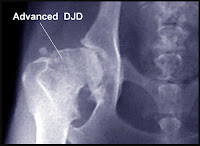 the cartilage thus slowing progression of DJD. Hill’s created J/D which is a prescription diet for animals with arthritis containing high levels of fatty acids. In developing this food they did numerous studies and found that animals with arthritis showed increased range of motion and weight bearing, along with decreased pain after feeding the J/D diet for three to six months.
the cartilage thus slowing progression of DJD. Hill’s created J/D which is a prescription diet for animals with arthritis containing high levels of fatty acids. In developing this food they did numerous studies and found that animals with arthritis showed increased range of motion and weight bearing, along with decreased pain after feeding the J/D diet for three to six months.In addition, a follow up study found that feeding the J/D allowed owners to decrease the dose of nonsteroidal anti-inflammatory drugs such as Rimadyl while maintaining a comparable level of comfort. The amazing fatty acid can not only help prevent DJD but also aid in managing pain.
Fatty acids have also been thought to improve treatment of chronic kidney disease, cancer and heart failure. Essentially they have the potential to help with so much and there is relatively no downside. The most common side effects are soft stool or diarrhea, if you notice this just back off on the amount you are adding to your pet’s diet. It is also reported that extremely high levels of dietary fatty acids can cause decreased blood clotting ability but this is very rare.
 There are multiple ways to increase the amount of fatty acids to your pet’s diet. An easy way would be to feed Hill’s J/D diet, the downside is it is expensive and once exposed to air fatty acids begin to break down and become less effective. There are also many types of veterinary products on the market as well. I find it easiest to buy fish oil capsules from Whole Foods (or any other vitamin store) and toss a few in with my dog’s food. The “dose” is 180 mg EPA per 10 pounds but I give my dogs two to three times this amount and have not had any problems.
There are multiple ways to increase the amount of fatty acids to your pet’s diet. An easy way would be to feed Hill’s J/D diet, the downside is it is expensive and once exposed to air fatty acids begin to break down and become less effective. There are also many types of veterinary products on the market as well. I find it easiest to buy fish oil capsules from Whole Foods (or any other vitamin store) and toss a few in with my dog’s food. The “dose” is 180 mg EPA per 10 pounds but I give my dogs two to three times this amount and have not had any problems. Tuesday, December 1, 2009
Kitty Cavities
 Here is another posting on dental disease because it is a topic vitally important to your pet’s overall health. I would like to highlight lesions that cats get called feline odontoclastic resportive lesions or FORLs. These are similar to human cavities in that there is a defect in the enamel of the tooth and it is very painful. If your cat is over the age of 5 years old then there is a 72% chance a FORL is present.
Here is another posting on dental disease because it is a topic vitally important to your pet’s overall health. I would like to highlight lesions that cats get called feline odontoclastic resportive lesions or FORLs. These are similar to human cavities in that there is a defect in the enamel of the tooth and it is very painful. If your cat is over the age of 5 years old then there is a 72% chance a FORL is present.These nasty FORLs are usually found along the outer surface of the tooth where it meets the gum line. They can present in many stages requiring dental x-rays to determine if the tooth root is involved. At the beginning stage an enamel defect is present which then progresses as the FORL penetrates the tooth and invades the pulp cavity. As the lesion develops it becomes increasingly more painful for your cat. Treatment entails a full dental exam under anesthesia and surgical extraction of the offending tooth.
Veterinarians are not sure why this happens but we do know it is extremely painful and unpleasant for your kitty. While clinical signs such as difficulty eating, drooling, bleeding at the site and dropping food from the mouth may be present; some cats to not show any obvious signs of pain. You should check your cat’s teeth monthly for any obvious FORLs which appear as pink or red defects in the tooth where it meets the gum. In addition, at your yearly visit to Friendship your veterinarian will perform as thorough an oral exam as your cat will tolerate (cats can be very opinionated about who they allow to look into their mouth).

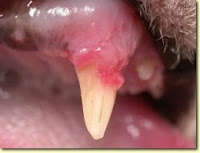
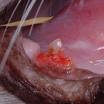
As with all dental disease, FORLs can lead to increased bacteria circulating in the blood stream resulting in liver, kidney and heart disease. Finding and treating these lesions early will result in a healthier, happier kitty.
Tuesday, November 24, 2009
Thanksgiving Tips

Here are a few tips so that you and your pets can have a happy holiday--without a trip to the emergency room at the animal hospital.
Though it’s tempting to share Thanksgiving delicacies with your pets, the best thing you can do for your cat or dog is simply to continue feeding them their regular diet. Giving your pet tasty table scraps can result in serious gastrointestinal issue ranging from mild vomiting and diarrhea to severe, life-threatening pancreatitis.
If you simply can’t resist sharing Thanksgiving dinner with your furry family members, please limit it to a few pieces of turkey meat only. Avoid side dishes because these may be high in fat. Onions, garlic, grapes, and raisins are actually toxic to pets, so these are to be avoided too. Absolutely do NOT give your dog bones to chew on: The marrow is extremely fatty and will almost always result in a nasty case of pancreatitis.
If you simply can’t resist sharing Thanksgiving dinner with your furry family members, please limit it to a few pieces of turkey meat only. Avoid side dishes because these may be high in fat. Onions, garlic, grapes, and raisins are actually toxic to pets, so these are to be avoided too. Absolutely do NOT give your dog bones to chew on: The marrow is extremely fatty and will almost always result in a nasty case of pancreatitis.
 Advise houseguests to keep chewing gum and medications out of reach from the furry paws and teeth of any nosy pets. Sugarless gum containing Xylitol can cause liver failure and low blood sugar, both of which can be life threatening. If your pet does get into any medications be sure to note the type, the quantity and the strength and bring your pet in to the hospital or call ASPCA Animal Poison Control immediately.
Advise houseguests to keep chewing gum and medications out of reach from the furry paws and teeth of any nosy pets. Sugarless gum containing Xylitol can cause liver failure and low blood sugar, both of which can be life threatening. If your pet does get into any medications be sure to note the type, the quantity and the strength and bring your pet in to the hospital or call ASPCA Animal Poison Control immediately.After a big Thanksgiving meal, when you and your family head outside for a walk, don’t forget to bring the pups along too. It’s the perfect time to spend a little time together and get in some extra exercise.
I know you’ll do your best to keep your pets safe and healthy on Thanksgiving, but if any of the above scenarios do happen, I will be seeing emergencies at the hospital on Friday. Hopefully there won’t be too many patients who overindulged on Thursday and wake up with an upset stomach.
Happy Thanksgiving from all of us at Friendship Hospital for Animals!

Thursday, November 19, 2009
Urinary obstruction in cats

Linus, a six-year-old neutered male cat was brought in when his owner noticed him making multiple trips to the litter box. He would position himself as if trying to urinate but nothing would come out. While he did this, he cried, which his owner thought was unusual behavior.
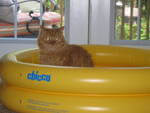 On presentation Linus was moderately dehydrated, slightly depressed and his heart rate was lower than I would have liked at 180 beats per minute. During abdominal palpation I was able to feel a very large, hard bladder and determined that he had a urinary obstruction. After quickly placing an intravenous catheter we collected blood to check his electrolyte status.
On presentation Linus was moderately dehydrated, slightly depressed and his heart rate was lower than I would have liked at 180 beats per minute. During abdominal palpation I was able to feel a very large, hard bladder and determined that he had a urinary obstruction. After quickly placing an intravenous catheter we collected blood to check his electrolyte status.
The potassium in his blood was dangerously high, which can lead to cardiac arrhythmias and rapidly result in death. We started Linus on IV fluids and gave him a medication to help lower his potassium. Because he was unable to urinate, the waste products normally excreted in urine were building up and making him feel sick.
I performed a cystocentesis which involves sticking a needle into his bladder to remove the urin e and relieve some of his discomfort. Because urinary obstruction is very painful for kitties, Linus was also given pain medication. X-rays showed he had stones in his bladder causing the obstruction. In male cats (and also male dogs), the urethra is very narrow, so it’s easy for things to get stuck in it. Stones are not the only cause of urinary obstructions in cats; mucus plugs, inflammatory cells, and crystals can also a blockage.
e and relieve some of his discomfort. Because urinary obstruction is very painful for kitties, Linus was also given pain medication. X-rays showed he had stones in his bladder causing the obstruction. In male cats (and also male dogs), the urethra is very narrow, so it’s easy for things to get stuck in it. Stones are not the only cause of urinary obstructions in cats; mucus plugs, inflammatory cells, and crystals can also a blockage.
I used an injectable anesthetic agent to sedate Linus so a urinary catheter could be passed. This was necessary for many reasons. First, he needed to be able to empty his bladder. We also needed to start him on intravenous fluids to flush out his system. This would decrease the dangerously high levels of potassium and waste products he had been unable to eliminate. And finally, given Linus’s current state, he was at an increased risk for general anesthesia, so I wanted to stabilize him before going to surgery.
The next morning, Linus went to surgery to have the stones removed via a cystotomy. He was sent home the next day. Analysis revealed that his stones were struvite. This was great news, because this type of urolith responds very well to diet change and has a low level of recurrence. Linus started his new prescription diet and his owners report he is like a new cat at home.
Urinary obstruction is incredibly common and can quickly become fatal, so it’s important for all owners of male cats to be aware of the condition and its symptoms. If you ever notice your cat making multiple trips to the litter box, straining to urinate and vocalizing, please bring him in immediately.

 On presentation Linus was moderately dehydrated, slightly depressed and his heart rate was lower than I would have liked at 180 beats per minute. During abdominal palpation I was able to feel a very large, hard bladder and determined that he had a urinary obstruction. After quickly placing an intravenous catheter we collected blood to check his electrolyte status.
On presentation Linus was moderately dehydrated, slightly depressed and his heart rate was lower than I would have liked at 180 beats per minute. During abdominal palpation I was able to feel a very large, hard bladder and determined that he had a urinary obstruction. After quickly placing an intravenous catheter we collected blood to check his electrolyte status.The potassium in his blood was dangerously high, which can lead to cardiac arrhythmias and rapidly result in death. We started Linus on IV fluids and gave him a medication to help lower his potassium. Because he was unable to urinate, the waste products normally excreted in urine were building up and making him feel sick.
I performed a cystocentesis which involves sticking a needle into his bladder to remove the urin
 e and relieve some of his discomfort. Because urinary obstruction is very painful for kitties, Linus was also given pain medication. X-rays showed he had stones in his bladder causing the obstruction. In male cats (and also male dogs), the urethra is very narrow, so it’s easy for things to get stuck in it. Stones are not the only cause of urinary obstructions in cats; mucus plugs, inflammatory cells, and crystals can also a blockage.
e and relieve some of his discomfort. Because urinary obstruction is very painful for kitties, Linus was also given pain medication. X-rays showed he had stones in his bladder causing the obstruction. In male cats (and also male dogs), the urethra is very narrow, so it’s easy for things to get stuck in it. Stones are not the only cause of urinary obstructions in cats; mucus plugs, inflammatory cells, and crystals can also a blockage.I used an injectable anesthetic agent to sedate Linus so a urinary catheter could be passed. This was necessary for many reasons. First, he needed to be able to empty his bladder. We also needed to start him on intravenous fluids to flush out his system. This would decrease the dangerously high levels of potassium and waste products he had been unable to eliminate. And finally, given Linus’s current state, he was at an increased risk for general anesthesia, so I wanted to stabilize him before going to surgery.
The next morning, Linus went to surgery to have the stones removed via a cystotomy. He was sent home the next day. Analysis revealed that his stones were struvite. This was great news, because this type of urolith responds very well to diet change and has a low level of recurrence. Linus started his new prescription diet and his owners report he is like a new cat at home.
Urinary obstruction is incredibly common and can quickly become fatal, so it’s important for all owners of male cats to be aware of the condition and its symptoms. If you ever notice your cat making multiple trips to the litter box, straining to urinate and vocalizing, please bring him in immediately.

Tuesday, November 17, 2009
Toby's Bladder Stones
Toby is a five-year-old Yorkie whose owner noticed he had blood tinged urine after he had an "accident" in the house. Toby's owner immediately brought him into Friendship on emergency. besides being worried about the bloody urine, she was also alarmed that Toby had peed in the house, since he had never done this before. I assured her he most likely had a urinary tract infection, and submitted urine for analysis and culture. I then sent him home with a broad-spectrum antibiotic. Though the urinalysis results would be available the same day, we would need to wait three to five days for the culture to come back.
I had the urinalysis results back an hour later. There weer some inflammatory cells, which you can see with an infection, but no bacteria present. I advised Toby's owner to monitor his closely; if the signs continued and the culture was negative, Toby might have bladder stones, also known as uroliths. It was very important that she make sure he was able to pass urine. Since male dogs and cats have a narrow urethra compared with females, stones have a tendency to get stuck in this area. This creates a urinary blockage and requires emergent treatment.
When I called Toby's owner four days later with the negative culture results, she informed me that the bloody urine and accidents had not resolved with antibiotics. I had Toby come in immediately for an x-ray to see if any stones were present in his bladder. Sure enough, he had multiple bright white objects in his bladder consistent with uroliths. Luckily he was not obstructed and immediately surgery was not required.
Toby's owners had two options at this point. We could try switching his diet to see if the stones would dissolve. Alternatively, we could take him to surgery, remove the stones and submit them for analysis. His owners decided to go forward with surgery. I performed a cystotomy, entering the abdomen and making an incision in the bladder to remove the stones. Toby sailed through surgery and was able to go home the next day.
A few weeks later, the results of the stone analysis revealed that Toby had calcium oxalate stones. This was not great news, as this type of stone has a very high frequency of recurrence. Fifty percent of patients will have stones return within three years of initial diagnosis.
We started Toby on a prescription diet to alter the acidity of his urine and switched him from dry food to canned food. Thanks to its increased moisture content canned food would ideally create a more dilute urine. Toby's owners were instructed to take him out more frequently to prevent urine from sitting in his bladder too long.
Tuesday, November 10, 2009
H1N1 concerns
 I am speaking with WAMU this morning about the kitty in Iowa that tested positive for H1N1 and concerns for infection in our pet animals. The quick facts on this are the cat developed upper respiratory signs after two humans in the house were sick with flu like symptoms. Confirmation of infection with H1N1 was confirmed and the cat has since made a full recovery. It is believed that the cat was infected by the people in the house and not the other way around.
I am speaking with WAMU this morning about the kitty in Iowa that tested positive for H1N1 and concerns for infection in our pet animals. The quick facts on this are the cat developed upper respiratory signs after two humans in the house were sick with flu like symptoms. Confirmation of infection with H1N1 was confirmed and the cat has since made a full recovery. It is believed that the cat was infected by the people in the house and not the other way around. We have long known that many viruses can pass between people and animals so this event is not wholly unexpected. The important things to keep in mind are that this is an isolated incident and extensive testing by the World health Organization has determined that infection in other species does not indicate that the H1N1 virus has mutated to a more virulent form.
We have long known that many viruses can pass between people and animals so this event is not wholly unexpected. The important things to keep in mind are that this is an isolated incident and extensive testing by the World health Organization has determined that infection in other species does not indicate that the H1N1 virus has mutated to a more virulent form. 
In order to keep your own animals healthy you should continue to practice good hygiene such as washing hands frequently, covering your mouth and nose when sneezing or coughing and perhaps you should avoid sneezing in your cats face. It is also a good idea not to snuggle with your animals if you are not feeling well. If your cat or dog does develop flu-like symptoms see your veterinarian immediately. There are many viruses that cause similarly clinical signs to influenza and most respond to simple supportive care.
Wednesday, November 4, 2009
Fox 5 at Friendship!
We had a great time this morning with Holly Morris and Fox 5. In case you missed anything or would like some more information I have everything posted below:
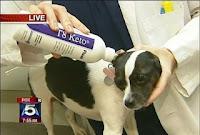
Winter care for your pets:
Watch it on Fox 5
Winter Dangers Post
Canine Influenza Post
A Case of Pneumonia Post
Dental tips:
Watch it on Fox 5
Dental Disease Post
Kitty Cavities Post

Winter care for your pets:
Watch it on Fox 5
Winter Dangers Post
Canine Influenza Post
A Case of Pneumonia Post
Dental tips:
Watch it on Fox 5
Dental Disease Post
Kitty Cavities Post
Tuesday, November 3, 2009
Winter dangers
 This Wednesday Fox 5’s Holly Morris will be spending the morning at Friendship starting bright and early at 6 am. Among the many awesome things we will be showing Holly around the hospital, I will be giving some tips on keeping your pets healthy and safe this winter. Here are my top 5 cold weather dangers for dogs and cats:
This Wednesday Fox 5’s Holly Morris will be spending the morning at Friendship starting bright and early at 6 am. Among the many awesome things we will be showing Holly around the hospital, I will be giving some tips on keeping your pets healthy and safe this winter. Here are my top 5 cold weather dangers for dogs and cats:1) Warm car engines: many people let their cats outside which is not a good idea on many levels but once it gets cold kitties really put themselves at risk for death by seeking shelter in a parked car. In an effort to warm up during a cold night cats will crawl up under the hood of a car and curl up on the warm engine block. This does not end well when you come out the next morning and fire up your car to head off for work. Luckily this is easy to avoid by keeping your kitties inside during the chilly months.

2) Antifreeze: this common chemical has a sweet taste so dogs and cats are actually attracted to it. If you are unaware your pet was exposed, by the time clinical signs become apparent it is often too late for treatment. The other nasty thing about antifreeze is that a tiny amount is all it takes to cause irreversible damage resulting in death. Avoid this by monitoring your pets at all times and keeping cats indoors.

3) Salting for snow and ice: many of the chemicals used to keep sidewalks and roads safe can be toxic to dogs and cats. This is can be avoided by cleaning paws after a walk so they don’t lick the chemicals off once you get home. If you will be salting your own property consider using Safe Paw Ice Melter to keep paws safe.
4) Rodenticide: another common toxicity to be aware of for both dogs and cats. The cold weather drives rats and mice into our homes and without question this is undesirable. In an effort to get rid of these unwanted visitors many people will put out poison. Keep this in mind, rodenticides don’t just kill rodents, they will kill any mammal that ingests it. Most rat poison is formulated to be tasty, attracting both rodents and our pets. If you must put a rodenticide in your house or on your property make sure your animals can’t get to it, remembering that the crafty rodent often will move the poison. Also warfarin based products are best since these are at least treatable if caught in time.
 5) Freezing temperatures: I think this shouldn’t need to be said but keep your pets inside when it gets cold. If the thermostat dips below 40 degrees Fahrenheit bring outside dogs in and don’t let the kitty out for the night. Animals are susceptible to frostbite and hypothermia just like us so please protect them.
5) Freezing temperatures: I think this shouldn’t need to be said but keep your pets inside when it gets cold. If the thermostat dips below 40 degrees Fahrenheit bring outside dogs in and don’t let the kitty out for the night. Animals are susceptible to frostbite and hypothermia just like us so please protect them.Hopefully these pointers will be helpful during the upcoming winter months. Please tune in to Fox 5 tomorrow morning to check out all the exciting things happening at Friendship.
Thursday, October 29, 2009
A cautionary tale of chocolate toxicity for Halloween
 With Halloween this weekend and the holiday season just around the corner everyone will have more candy around the house than usual which is an invitation for curious pups to steal a snack. Dr. Dana Begnoche’s dogs Lola and Widget have volunteered to be used as an example for what can happen if your dog eats too many chocolates.
With Halloween this weekend and the holiday season just around the corner everyone will have more candy around the house than usual which is an invitation for curious pups to steal a snack. Dr. Dana Begnoche’s dogs Lola and Widget have volunteered to be used as an example for what can happen if your dog eats too many chocolates.Lola and Widget came in after breaking into the Halloween candy stash one afternoon. Milk chocolate, which consists mostly of cream and sugar, is generally not a huge concern unless massive amounts are consumed but dark chocolate is another story. Among other treats there was a bag of dark chocolate M&M’s missing and we were not sure how much each dog consumed.
An injectable medication was used to induce vomiting in both dogs so we could empty their system of as much chocolate as possible. Lola was the prime suspect as her heart rate was in the 200 beats per minute range which is too fast and she was very agitated. Chocolate contains theobromine and caffeine, which are both classified as methylxanthines. Unfortunately, dogs are sensitive to the effects of methylxanthines which can cause hyperactivity, increased heart rate, gastrointestinal upset, tremors, seizures and potentially death when ingested at a toxic dose.

Widget vomited a moderate amount of chocolate but was not showing any clinical signs of chocolate toxicity. He was given activated charcoal by mouth, fluids under the skin and an injection of Pepcid to help settle his stomach. The fluids would help flush out his bladder which is important since the methylxanthines are excreted through the urine and can actually be reabsorbed if allowed to collect in the bladder. Widget was sent home with instructions to take out frequently to urinate and monitor for any vomiting or diarrhea.
Lola vomited slightly more chocolate than Widget but she was showing clinical signs of chocolate toxicity which required more aggressive treatment. We started her on IV fluids and gave her a medication to help slow down her heart rate. Overnight we checked her heart rate every hour in case it crept back up again and she needed an additional dose. Lola was also given oral activated charcoal to bind any of the chocolate that wasn’t expelled when she vomited. Other than being anxious and whining all night Lola did great and was sent home the next morning.

There are a few take home messages in this tale. First keep the candy far away from nosey dogs, even if you don’t think they are interested in eating it. Second, know what kind of chocolate your dog has been exposed to. The higher the cocoa content or more bittersweet, the smaller amount it takes to reach a toxic dose. Finally if your dog does eat chocolate bring them in to see us immediately so we can induce vomiting to remove as much as possible from their system. Most of the time they do not need to stay in the hospital and can go home with you immediately.
Happy Halloween from Friendship! We hope you won’t have a chocolate toxicity story of your own this holiday season but if you do we will be here to help your dog vomit.
As a side note Lilly will be dressed as a bumble bee and Sparkle as a pig on Saturday. Poppy is refusing to keep on the costume I got for her, so instead she will be going as a very bad dog.
Tuesday, October 27, 2009
Baxter's itchy ears
 Baxter is a nine month old Westie who presented for scratching his ears and shaking his head. A quick peak at his ears revealed the skin was very red and there was a waxy, dark brown discharge. It was clear he had a significant ear infection. The most common causes of these are allergies or when water gets in the ear canal either from swimming or getting a bath.
Baxter is a nine month old Westie who presented for scratching his ears and shaking his head. A quick peak at his ears revealed the skin was very red and there was a waxy, dark brown discharge. It was clear he had a significant ear infection. The most common causes of these are allergies or when water gets in the ear canal either from swimming or getting a bath.I obtained a swab of both ears to look at under the microscope and whisked Baxter off for a thorough ear cleaning. On the microscope slide there was a sea of yeast, which look like little purple bowling pins (see picture below). Bacteria in the shape of spheres or tubes can also be present which is why determining what organisms are causing the infection is critical to the treatment plan. In Baxter’s case I suspect this started with a bath as yeast infections are most commonly seen when water gets into the ear canal. The moisture becomes trapped in the ear and this creates the perfect environment for yeast and bacteria to flourish.
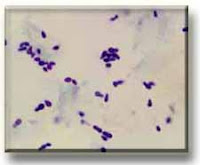
Poor Baxter’s ears were so uncomfortable he did not appreciate the ear cleaning but we were able to remove a large amount of discharge which would help him clear the infection. Once we were through he was sent home with a cleanser and topical medication for his owners to apply at home.

Some dogs struggle with chronic ear infections but hopefully this will not be the case with Baxter. By using the cleanser weekly and/or after bathing his owners should be able to prevent future infections from forming. Ear infections are very common and knowing the clinical signs and causes will go a long way in keeping your dog comfortable and preventing a trip to the vet.
Thursday, October 22, 2009
Exciting things to come!
There are many new things in the works at Friendship Tails these days and I am very excited to share them with you. My two special interests in veterinary medicine are shelter animals and canine cancer; recently I have been given the opportunity to become more involved with both.
Even before Westin was diagnosed I have always been interested in oncology. Unfortunately it is a huge part of treating companion animals and I have seen countless times how devastating it can be for owners. When 2 Dogs, 2000 Miles came through DC I realized that there was so much more I could be doing on top of just diagnosing and treating animals with cancer.
 This led me to consider the idea of starting a non-profit, which was a little overwhelming. I was then thrilled to discover that the National Canine Cancer Foundation had just started a DC chapter. So look forward to upcoming events where we can raise awareness and funds to further canine cancer research.
This led me to consider the idea of starting a non-profit, which was a little overwhelming. I was then thrilled to discover that the National Canine Cancer Foundation had just started a DC chapter. So look forward to upcoming events where we can raise awareness and funds to further canine cancer research.
One of my favorite things about Friendship is how closely we work with the Washington Humane Society and the Washington Animal Rescue League. Helping shelter animals has long been a passion of mine, hence the reason I have six animals living with me. Recently I was honored to be invited to participate in WHS’s Fashion for Paws program.
 Fashion for Paws is a series of events that raises money throughout the year culminating in April with a fashion show featuring people and their dogs. It is a genius way to create awareness for all that WHS does for the community as well as save the lives of many shelter animals. I had a great time last year attending as a guest and I am very excited to be participating this year.
Fashion for Paws is a series of events that raises money throughout the year culminating in April with a fashion show featuring people and their dogs. It is a genius way to create awareness for all that WHS does for the community as well as save the lives of many shelter animals. I had a great time last year attending as a guest and I am very excited to be participating this year.
In addition to what I am directly involved with, Friendship also donates proceeds from some of our online stores to the Humane Education Fund and supports the Marshall Legacy Institute. Not to mention we are open twenty four hours a day, every day for you and your pet. Sometimes I can’t believe how lucky I am that I get to work at such an amazing place.
Even before Westin was diagnosed I have always been interested in oncology. Unfortunately it is a huge part of treating companion animals and I have seen countless times how devastating it can be for owners. When 2 Dogs, 2000 Miles came through DC I realized that there was so much more I could be doing on top of just diagnosing and treating animals with cancer.
 This led me to consider the idea of starting a non-profit, which was a little overwhelming. I was then thrilled to discover that the National Canine Cancer Foundation had just started a DC chapter. So look forward to upcoming events where we can raise awareness and funds to further canine cancer research.
This led me to consider the idea of starting a non-profit, which was a little overwhelming. I was then thrilled to discover that the National Canine Cancer Foundation had just started a DC chapter. So look forward to upcoming events where we can raise awareness and funds to further canine cancer research.One of my favorite things about Friendship is how closely we work with the Washington Humane Society and the Washington Animal Rescue League. Helping shelter animals has long been a passion of mine, hence the reason I have six animals living with me. Recently I was honored to be invited to participate in WHS’s Fashion for Paws program.
 Fashion for Paws is a series of events that raises money throughout the year culminating in April with a fashion show featuring people and their dogs. It is a genius way to create awareness for all that WHS does for the community as well as save the lives of many shelter animals. I had a great time last year attending as a guest and I am very excited to be participating this year.
Fashion for Paws is a series of events that raises money throughout the year culminating in April with a fashion show featuring people and their dogs. It is a genius way to create awareness for all that WHS does for the community as well as save the lives of many shelter animals. I had a great time last year attending as a guest and I am very excited to be participating this year.In addition to what I am directly involved with, Friendship also donates proceeds from some of our online stores to the Humane Education Fund and supports the Marshall Legacy Institute. Not to mention we are open twenty four hours a day, every day for you and your pet. Sometimes I can’t believe how lucky I am that I get to work at such an amazing place.
Subscribe to:
Posts (Atom)







